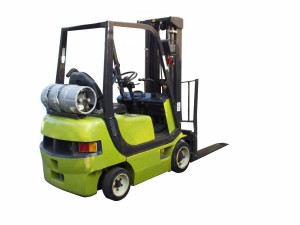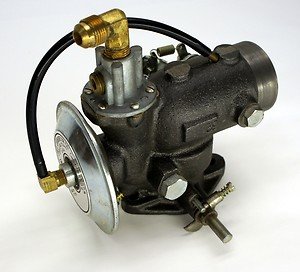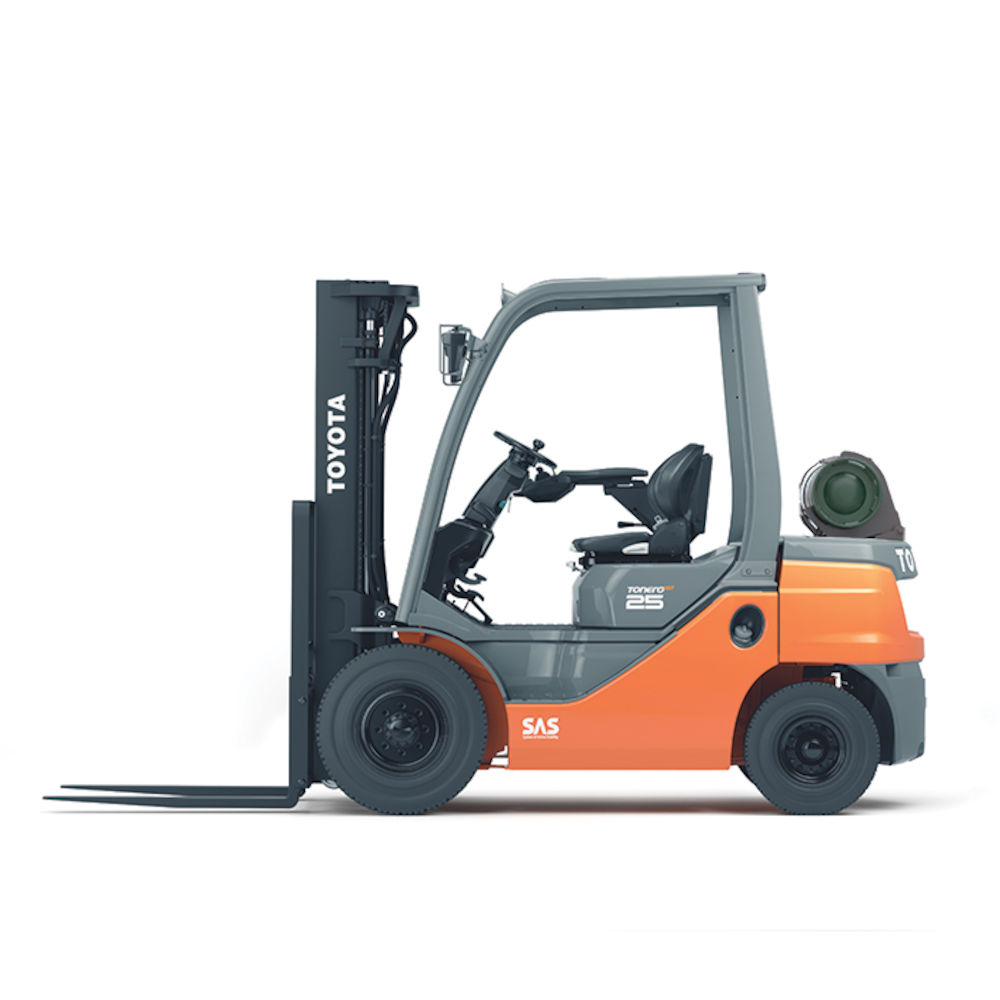Liquid Petroleum Gas (LPG) is also called GPL, LP Gas, propane or butane. LPG is chemically a mixture of hydrocarbon gases, which is inflammable and can be used as fuel in automobiles and heating appliances. LPG also finds its uses as an aerosol propellant and refrigerant. While used in forklift truck engines or any automobiles, it is also known as auto gas. LPG used in forklift trucks has different configuration and chemical composition. It may only be butane or propane, or a mixture of them both. According to weather conditions, the constituent quantity of propane and butane vary, with more concentration of propane in winters and less in the summers, in relation to butane, the other constituent. Propane is stored at a very high pressure of around 300 psi to keep the gas in liquid state.
Preparation of LPG involves refining of petroleum or natural gas. The liquid petroleum gas is derived from fossil fuel almost entirely and is obtained during refining of petroleum crude oil. Its history of emergence dates back to 1910 and was commercially introduced for the first time in 1912 in the United States. LPG fuel is more economic, being less expensive than gasoline, and does not degrade forklift engine performance. Propane is stored at a very high pressure of around 300 psi to keep the gas in liquid state.
- In rugged outdoor applications, you need the power, performance and reliability of a Crown LPG or diesel pneumatic tire forklift. Backed by our proven support network, Crown's internal combustion forklifts are ready to handle the tough assignments. C-5 Series 4000 - 6500 lb Capacity Internal Combustion Pneumatic Tire LPG Forklift.
- Today, LPG fuel systems are available for forklifts that are primarily designed to operate on other fuels. One can easily convert their systems to consume LPG via forklift Liquid Petroleum Gas (LPG) regulator, lines and valves. The most important element in every LPG conversion is the forklift LPG regulator.
- Forklifts powered by LPG have fuel systems made by several different manufacturers:” IMPCO systems are very popular and common on forklifts made before 2005. The most common item that fails is the model J regulator or the VFF30 lock off.
Power up your Forklift engines with SUPERGAS LPG Design for exceptional reliability, safety and productivity Forklift is an excellent tool for storage systems and handling. It can perform stacking, lifting, loading, distribution and a lot more with utmost safety.
LPG has gained its importance as an alternate fuel to diesel or petrol, and is widely being used for internal combustion engines in the forklift trucks. The fuel is cheaper than diesel or petrol but efficient enough to run on the power hungry forklift trucks. Despite having lower energy density and more equivalent consumption than diesel or petrol, LPG is available at cheaper price in the market, which encourages its use as fuel, and propane is presently the third highest fuel used worldwide. Hence, LPG is more economical and environment friendly than its counter-parts, diesel or petrol. Today, LPG fuel systems are available for forklifts that are primarily designed to operate on other fuels. One can easily convert their systems to consume LPG via forklift Liquid Petroleum Gas (LPG) regulator, lines and valves.
The most important element in every LPG conversion is the forklift LPG regulator. It comprises of a regulator vent, a regular diaphragm and a pressure relief valve. Regular vent can be thought of as a breather to the LPG regulator which allows it to breathe during normal operation in over pressure conditions.

The regulator is also known as a vaporizer. It performs one of the functions of which a carburetor performs in gasoline engines. It uses the heat from coolants of the forklift truck to help vaporizing the LPG into gaseous form. This part helps to control and manage the injection of gas into the engine so that only the right amount of fuel and pressure can be injected. It keeps the appropriate level of the fuel maintained to ensure fuel efficiency paired with engine performance. It also reduces the pressure in the process as one of its safety features. Another safety precaution involves cutting down the circuit of gas flow to the engine when it is static or stalled. It is done through electronic circuitry.
Regulator is smaller in size and finds its place easily in the engine. However, it is made of immense importance that only a professional mechanic with experience in LPG conversion work should install the LPG regulator in a gasoline operated engine. Additionally, one must note the availability of LPG, as it may not be easily accessible to some forklift operators.
More importantly, through the LPG regulator system, burning and conversion of fuel inside the engine will not produce chemicals that could potentially be harmful if inhaled. Another function of a carburetor in a gasoline engine is performed by the mixer of an LPG regulator. The mixer is mounted on the intake manifold. It senses the information from electronic control unit of the forklift truck and controls the amount of gas into the cylinders. The influx of right amount of gas in the cylinders is very important as a little variation in this amount either damages or reduces the efficiency of forklift engine. An excessive gas intake would result in loss of un-burnt liquefied petroleum gas, an increase in harmful exhaust and may cause excessive burning inside the engine. Download adobe illustrator cs6 for mac free. While a lesser than desired intake would affect the engine’s capacity to perform, would force the engine parts to work with less power intake resulting in loss of engine life.
Commercial LPG still derives from fossil fuels and is not lab made. Burning of LPG in the engine releases carbon dioxide, which is a known to contribute to greenhouse gas. It also releases some amounts of carbon monoxide, which is highly poisonous in nature. However, the released volume of carbon dioxide as a result of burning, is less than that released by diesel or petrol fuels. In comparison with coal, it releases 70% of the carbon dioxide and 81% of what is produced by fuel oil. Hence, LPG is believed to be more environment friendly than coal or oil.
Since LPG regulator is basically a conversion device, which converts a gasoline engine to operate on Liquefied Petroleum Gas, it is prone to develop certain faults like any other piece of engine mechanism. If not checked and inspected regularly, a malfunctioning regulator can potentially harm the engine parts. Hence, over time, a forklift LPG regulator needs maintenance to meet standards for its optimum functionality. If there is any irregularity with the fuel system, the regulator should be immediately checked, repaired or replaced when necessary. Common problems that affect the forklift regulator include freezing and frosting. Initially, the frosting and freezing are considered safe as long as the there is no irregularities with how the engine works. There are different kinds of replacements available in the market such as adjustable, integral, automatic, and first-stage or second-stage regulators. The choices vary differently depending on the brand, model and applications of the forklift.
Forklift LPG Regulator Photos
If you are on the lookout for a new forklift to meet your material handling needs, there is one question that you will inevitably encounter: LPG or Battery Electric?


To resolve this issue we will weigh up the financial and environmental costs associated with this decision. We will also determine significant points that you will need to take into consideration when purchasing a Battery Electric or LPG forklift.

A little History…
• Batteries have been in use in a materials handling context for at least 200 years. The most common battery used in the materials handling industry, currently, is the lead acid battery, whose original form was patented by French physicist Gaston Planté in 1859.
• The first ever Internal Combustion Engine (ICE) can be traced back to Dutch polymath Christiaan Huygens’ experiments in 1673, where he used gunpowder to drive water pumps to supply water to the Versailles palace gardens.
Performance – some pros and cons:
The above table illustrates the main pros and cons of each power source. The LPG forklifts main advantage over Battery Electric forklifts is their ability to provide consistently strong power. Batteries can be slower to accelerate and lift and also travel slower than their LPG counterparts. Whilst LPG forklifts are stronger, Battery Electric forklifts have a significantly lower noise output. Battery models have fewer moving parts and no exhaust or engine noise, producing only one quarter of the noise of LPG forklifts.
Cost Comparison
In terms of initial cost LPG forklifts are significantly less expensive than electric forklifts. After this however, the key costs are found in fuel and maintenance. It is here that the benefits of battery electrics are most keenly felt.
The graph below, provided by NACCO, shows the total cost of ownership for electric vs. ICE lift trucks, including the cost of two batteries and one charger at year zero. Over five years, an electric truck saves more than 8 per cent in total costs.
The initial cost of an electric forklift can be double the price of its ICE equivalent, although it is important to take into consideration the total cost of ownership upon your purchase.
Environmental Impact:
When the working environment is considered, electric trucks can easily be seen as superior to ICE models. As electric models do not emit any exhausts, indoor air quality is greatly improved. Depending on your application, this can make a big difference:
Take a food distribution centre for example. An internal combustion engines exhaust might be deemed unacceptable, or harmful to your product. The lack of exhaust fumes ensures the integrity of your product as indoor air quality is improved by eliminating all exhaust. Money is also saved on elaborate and expensive HVAC systems that can use a lot of power. Furthermore, your employees are not adversely affected by poor quality air inside the facility.
Although, it is important to factor in that batteries still require electricity from the grid and are far from perfect in terms of greenhouse gas emissions.
Internal combustion engines (diesel and LPG) regularly require servicing and a top up of consumables such as engine oil, transmission and radiator fluids and filters – parts that are both considerable financially and which can be very harmful to the environment if not disposed of properly.
Lpg Forklift Emissions
Conclusion? Application! Application! Application!

The most important aspect of choosing the right forklift for your operation is to consider your application and its needs. Food distribution centres are strongly encouraged by OHS standards, but not obliged, to operate with battery electrics. On the other hand, for big trucks, the only viable option on the market is diesel power.
Lpg Forklift For Sale
If you’re looking at operating and managing a large fleet, then economies of scale will definitely lower battery charging and maintenance cost. The same however, can be said for LPG supply. In a small to medium warehouse scenario operating in narrow aisles, you may desire a battery electric forklift in order to minimise exhaust fumes. However, if your forklift will be required both in and outdoors on a regular basis, then perhaps an ICE truck will be more suited to the varied weather conditions. As you can see, there are many different elements to consider. The decision will thus depend on the specifics of your site and your intended applications.
Small Propane Forklifts
Buy or rent electric forklifts today
Lpg Forklift Hose
At Adaptalift, we have a range of electric and internal combustion forklifts that are available for use. Whether you want to buy forklifts or rent forklifts, our friendly team can help with all of your needs to ensure that your jobs get done on time and within budget. We pride ourselves on providing a standout level of customer service and always offer expert advice as to the best options for your particular requirements. For more information or assistance, call us here at Adaptalift. Alternatively, feel free to fill out a contact form and we’ll get back to you as soon as possible.
